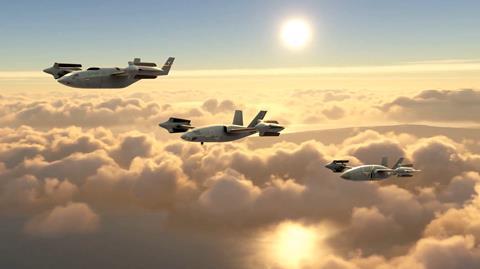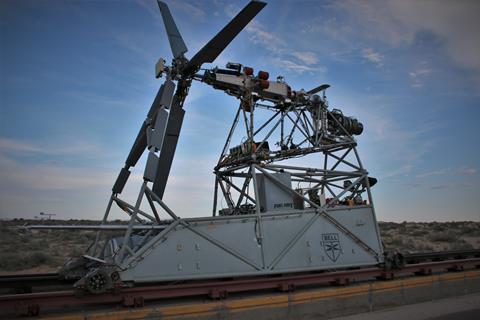The US military’s secretive technology development agency is advancing a programme to develop a vertical take-off and landing aircraft that is also capable of achieving fixed-wing jet speeds.
The Defense Advanced Research Projects Agency (DARPA) has selected four competitors for the X-plane project, which it calls the Speed and Runway Independent Technologies, or Sprint, project.

“The goal of the programme is to provide these aircraft with the ability to cruise at speeds from 400-450kt [740-830km/h] at relevant altitudes and hover in austere environments from unprepared surfaces,” DARPA says.
The agency selected Bell Textron, Northrop Grumman, Piasecki Aircraft, and Boeing subsidiary Aurora Flight Sciences to participate in Phase 1A of the Sprint effort.
The four aerospace manufacturers were selected on 1 November, according to an update published on DARPA’s website. According to the initial contract announcement, participants will have six months for Phase 1A.
At the conclusion of that period, DARPA will evaluate progress of each team and select as many as four or a few as one or none to advance. The agency says the contract awards for Phase 1B will be issued roughly in May 2024.
While DARPA plans to build and fly working aircraft for Sprint, the agency also wants the programme to act as a proof-of-concept, demonstrating new technologies that can be “scaled to different size military aircraft”.
The agency is partnering on the new experimental aircraft effort with US Special Operations Command (SOCOM).
The headquarters that oversees the USA’s elite troops runs a separate procurement system independent of those operated by the army, navy and air force. This includes the purchase of specially-modified aircraft or types entirely unique to the US inventory.
Speaking at the Special Operations Forces Week conference in May, SOCOM acquisitions executive Jim Smith said that Washington’s elite troops are interested in combining the performance of a conventional jet with the versatility of a tiltrotor or helicopter.
“We think it fits very well into ensuring we can move long distances, in operationally relevant times to support our forces,” Smith said of the Sprint project.
A key aspect of the effort, Smith revealed at the event in Tampa, Florida, will be producing a design that can operate without significant ground infrastructure – a so-called “runway independent” aircraft.

He added the effort will incorporate “fairly nascent technologies” into a clean-sheet design.
Textron subsidiary Bell appears to have one of the most advanced Sprint proposals, with enabling technologies already in ground testing. The helicopter manufacturer calls its concept High-Speed Vertical Take-Off and Landing (HSVTOL).
The concept envisions an aircraft that looks like a tiltrotor while on the ground and in vertical flight mode. However, after reaching sufficient speed, the HSVTOL rotor blades would fold back into a more aerodynamic profile and the aircraft would fly like a fixed-wing jet.
During a January tour of Bell’s Fort Worth, Texas headquarters, executive vice-president for engineering Jason Hurst told FlightGlobal that Bell has spent years and invested significant resources toward the goal of producing a realistic, workable HSVTOL design that could be turned into a functioning aircraft.
“We’re looking for government partners,” Hurst said at the time. “We’re burning down as much risk as we can without getting into the air.”
The effort has been underway since at least 2017, when Bell filed a patent application with the US government for a “tiltrotor aircraft having rotary and non-rotary flight modes”.
Bell in September began sled testing on an HSVTOL propulsion system test article at Holloman AFB in New Mexico.
Aurora revealed details of its approach on 15 November. The Boeing subsidiary says it will pursue a fan-in-wing design based around a “high lift, low drag” blended-wing-body (BWB) airframe.
Drawing on Boeing’s experimental X-48 BWB type, the Aurora Sprint aircraft will incorporate embedded engines and moderate sweep, with a vertical flight design comprised of embedded lift fans linked to the engines via mechanical drives.
Story updated on 15 November to include details of Aurora Flight Sciences’ DARPA Sprint design.
















































